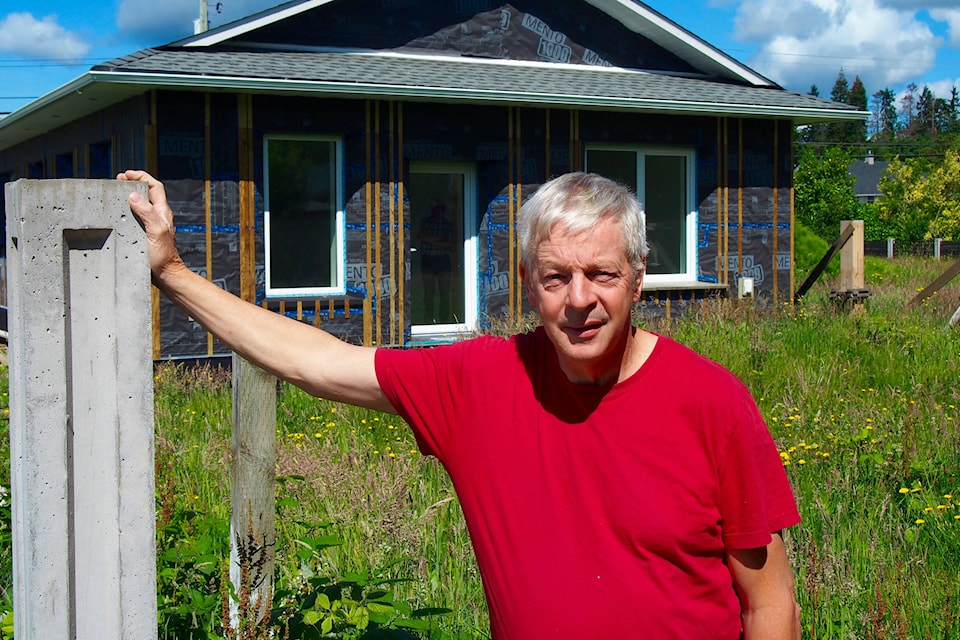MIKE YOUDS SPECIAL TO THE NEWS
Jimmy McCombie has been busy behind a lens.
A retired carpenter with a flair for YouTube how-to videos, McCombie was intrigued by what he spotted off Gertrude Street last year. Builder George Koning was laying the foundation for a “passive house,” an ultra-low energy home.
Since then, McCombie has shot 49 videos documenting every aspect of the home’s design and construction. All posted on YouTube, they detail Koning’s use of super-insulation, airtightness, high-performance windows, energy recovery ventilation and passive solar effect.
RELATED: Luxury condo buildings use twice as much electricity as older buildings in B.C.: report
What most surprises McCombie is the lukewarm reception he gets while spreading the wisdom.
“We’re finding there’s not too much interest,” McCombie said. “It surprises me when we’re seeing climate change.”
“Passivhaus” construction took off in Europe years ago, building on research and experience that originated in Canada and the U.S. in response to the 1973 energy crisis. Standards in North America, where fewer passive homes are built, are set and certified by the U.S. Passive House Institute.
From a distance, Koning’s two-bedroom, 1,700 square-foot rancher doesn’t stand out. Up close, the story of its evolution over the past three years begins to unfold.
“I have chosen to build to a passive home standard, which is the highest standard you can achieve,” he explained. “This house will use 90 percent less energy, yet the comfort level in the home will be better than any other home built in the city.”
Unlike net-zero houses, designed to generate as much energy as they use, passive houses use an absolute minimum amount of energy for heating and cooling, as much as 90 percent less than conventional homes.
A licensed builder, Koning completed his first house 40 years ago and has always had an interest in energy efficiency. With his mother confined to a wheelchair, he also grew interested in better accommodating the needs of people with disabilities. He is married to a former licensed practical nurse (LPN) and once worked with people with disabilities, providing direct experience. Adapting this knowledge, he built the first wheelchair-accessible home in the Valley.
His latest house represents state-of-the-art energy efficiency plus features for disabled people.
“The design was computer-modelled using passive house software,” Koning said.
Walls 20 inches thick are framed with 2X6 studs rather than 2X4s to hold more R80 insulation, also used in the attic. The concrete-pad floor is underlaid with 12 inches of expanded polystyrene foam.
“The house wrap has to be extremely tight. This gives you your greatest increase in efficiency.”
Windows are triple-glazed, argon-filled and low-e glass. Larger windows face south.
“The exterior glazing and sizing are key. The sun plays a huge role in heating the house.”
A German-engineered air-to-air heat exchanger moves fresh air over an electric coil for heating. The house is also equipped with a hot water tank supported by a CO2 heat pump four times more efficient than electric.
At this point, Koning is a rare bird. Surprisingly few passive homes are being built. BCIT teaches a course on the subject, prompting one of the instructors to have a look at the Koning’s project.
“He was blown away by how much I had pulled off, the detailing,” Koning said with obvious pride. “He said, basically, I nailed it.”
Why are more builders not advancing to passive houses? Cost is a key factor, although there are too many variables to make a straight-across comparison with conventional homes, Koning said.
Higher construction costs are offset by the lower cost of utilities over time and durability, he noted. His windows, for example, are designed to last 40 to 50 years compared to 25. Furnace installation was $14,000, but the cost of these items is sure to drop over time as the new building code progresses in phases to greater energy efficiency.
RELATED: Energy efficient home upgrades could net rebates and free kits during spring renovations
Koning believes the market concentrates on quick sale to the masses rather than on homes that cater to specific human needs or the highest environmental standards. That will have to change, though. B.C.’s new building code incorporates the Energy Step Code, phased in over time, the builder noted. The goal by 2032 is to achieve net-zero energy in all new homes. Rather than being prescriptive, the new code identifies an energy-efficient target and allows builders to decide how they achieve it.
“Basically, if you don’t step up to one of the higher levels of construction, you’re building an obsolete house.
“We just need the courage to try it,” he added. “Honestly, if I can do it, others can do it. The builders in town just have to get their heads around the new criteria. The physics behind it is real science, but once you embrace the principles you can transfer those principles to multiple locations.”
McCombie plans to create a website dedicated to the project. In the meantime, his videos can be viewed here.
